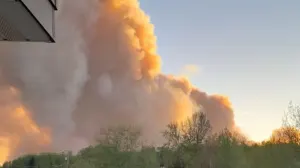
Why heat waves and power blackouts are such a deadly combination in some cities
A team of researchers studied deaths and hospital visits during extreme heat events in three U.S. cities to find out how blackouts amplified the mortality rate.
Heat is already the leading contributor to weather-related deaths in the United States. And the increase in extreme heat events puts an extra strain on the country’s power grids, sometimes resulting in blackouts. This can be a deadly combination, depending on where you live.
Recent research aims to show how blackouts during heat waves amplify the number of both heat-related emergency room visits and deaths. The work, penned by researchers from the United States and Canada, uses modelling and a large number of data sets to dig into the present and future of this phenomenon in three U.S. cities: Detroit, Atlanta, and Phoenix.
“It’s kind of working backwards: We want to know the health impacts of heat. But then we want to know the health impacts of heat under specific situations,” Scott Krayenhoff, an assistant professor at the University of Guelph’s school of environmental sciences and one of the paper’s authors, told The Weather Network.
When extreme heat events hit a city, the number of people turning to AC to cool their homes increases, putting added strain on the power grid. At the same time, heat can cause powerlines to expand and sag, potentially posing fire hazards. To mitigate this, operators may limit the amount of power passing through the lines. As some types of power plants (such as nuclear, coal and natural gas) heat up, they also end up losing efficiency.
Eventually, all of this can lead to parts of a city losing power and, in these cases, the AC cuts out, exposing people to potentially higher indoor temperatures.
When the team modelled a multi-day heat wave in which these cities lost power, the estimated number of heat-related deaths more than doubled. In a worst case future scenario, blackouts during a multi-day heat wave in Phoenix could see more than 50 per cent of the desert city’s population require medical attention.

People are seen moving around downtown Atlanta, Georgia. (Luis Negron / Pexels)
Each of the three cities fared differently under different circumstances. Under present conditions, Detroit saw the most mortalities during heat waves when the power remained on, at 15 cases per 100,000 people, compared to 0.5 in Atlanta and 1.3 in Phoenix. According to Krayenhoff, this could be because there’s less AC adoption in Detroit compared to the other cities, and, quite simply, people are less used to heat waves.
But, since Phoenix is already much hotter on average, it fared the worst when the power went out.
The team modelled a five-day heat wave in which the grid went down, and used historic temperatures from each city. For Detroit and Atlanta, the maximum temperature reached 35°C in the afternoon. Meanwhile, in Phoenix, the lowest daily high temperature in that five-day span was 43°C. In this scenario, Phoenix saw around 13,250 deaths, while Atlanta and Detroit saw 6 and 221 deaths, respectively.
READ MORE: More than half the world's large lakes are drying up, study finds
The researchers used data sets linking extreme heat events to heat deaths and hospital visits, but they also included demographic info (such as age and income bracket), rates of AC adoption, tree coverage, outdoor and indoor temperatures (which is important given people in the US spend around 90 per cent of their time indoors), and others.
Though the situation is concerning, especially as the planet continues to warm as a result of heat-trapping emissions from burning fossil fuels, the paper also suggests some pathways forward. These include finding ways to make power grids more heat-resistant, and coating roofs in high-albedo materials (materials that reflect light and, thus, heat). Additionally, the paper shows that increasing tree canopy — which shade and cool streets — by 50 per cent compared to where the cities are at now can reduce heat mortalities by 14 per cent, 19 per cent, and 27 per cent for Atlanta, Detroit, and Phoenix, respectively.
Thumbnail Image: Major Tim Smith, right, and volunteer Adrian Keller fill a cooler with water at a heat relief station at the Salvation Army Phoenix Citadel on June 15, 2021 in Phoenix, Arizona. The National Weather Service has issued an excessive heat warning for much of central Arizona, which is expected to be in effect through the weekend. (Photo by Caitlin O'Hara/Getty Images)











